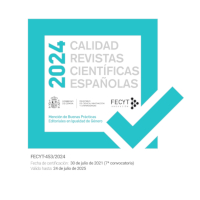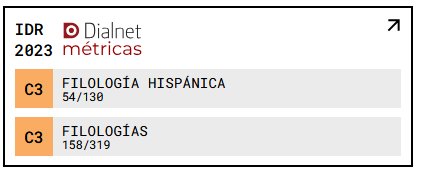Genre et originalité stylistique de la poésie kazakhe de la première moitié du XXe siècle
DOI :
https://doi.org/10.18172/cif.6323Mots-clés :
Mouvement national de libération, questions philosophiques, originalité de la versification, poésie kazakhe, poésie nomadeRésumé
L’article analyse les particularités de la poésie kazakhe de la première moitié du XXe siècle, caractérisée par une versification singulière et le reflet du mouvement national de libération. Cette poésie intègre des thèmes philosophiques et représente l’homme comme une partie de l’univers dans un système de valeurs. L’étude place la poésie kazakhe dans le contexte de la littérature mondiale, en soulignant ses racines nomades et son impact sur le développement littéraire. Les méthodes d’analyse et de comparaison permettent d’examiner les aspects sémantiques et structurels du vers kazakh, tout en tenant compte des conditions politiques et historiques. La recherche met en évidence le rôle de la poésie en tant qu’outil culturel et éducatif, favorisant la conscience historique, la pensée critique et la valorisation de l’identité nationale. L’examen de l’originalité du genre et du style soutient les programmes éducatifs visant à renforcer les compétences culturelles et la sensibilité littéraire des élèves.
Téléchargements
Références
Abril, J. C. (2025). Culture Efficacy: An Alternative to Collective Efficacy. Review of Law and Social Sciences, 3(1), 155-177. DOI: https://doi.org/10.71261/rlss/31.155.177
Altai, A. D., and Aituganova, S. S. (2019). Features of Kazakh literature in the XV-XVIII centuries. International Academy Journal Web of Scholar, 7(37), 25-33.
Altybaeva, S. M. (2018). Казахская проза периода независимости: традиция, новаторство, перспективы [Kazakh prose of the period of independence: Tradition, innovation, prospects]. Gylym.
Asankulova, B. S. (2012). Motives of moral and legal education in the work of Kazakh zhyrau. In Pedagogical skills: Materials of the I International Scientific Conference (pp. 362-363). Buki-Vedi.
Beisebayev, A. (1992). Национальное и интернациональное в современной Казахской поэзии: (60-80 годы) [National and international in modern Kazakh poetry (60-80 years)]. Thesis for the degree of PhD in Philological Sciences. Kazakh National University.
Belger, G. (2006). Spiritual shepherds of the nation. Thought, 3, 72-80.
Denys, I. (2024). Language as an important means of information encoding. Library Science. Record Studies. Informology, 20(1), 8-11. DOI: https://doi.org/10.63009/lsrsi/1.2024.08
Gaziev, I. M. (2008). The origin of professionalism in the musical culture of the ancient Turks. Bulletin of the South Ural State Humanitarian and Pedagogical University, 12, 181-183.
Idelbaev, M. K. (2018). Professional improvisational creativity in the literature of Turkic authors. Bulletin of the North-Eastern Federal University named after M.K. Ammosov: Epic Series, 2, 5-9.
Kanapyanov, B. M. (2020). “Абай вдохнул в пространство души казахское самосознание…” [“Abai breathed Kazakh self-consciousness into the space of the soul...”]. Profile, 5, 2-4.
Kongyratbay, T. A. (2021). Some problems of ethnic study of the heroic epic. Eposovedenie, 24(4), 15-22. DOI: https://doi.org/10.25587/e4294-4960-9721-z
Kongyratbay, T. A. (2022). Once again about the epic heritage of KorKuT. Eposovedenie, 2022(2), 28-39. DOI: https://doi.org/10.25587/n8974-5171-2692-o
Koshekova, A. A., Alpysbay, S. E., and Chakenova, B. A. (2016). The emergence of zhyrau and its activities. Actual Problems of the Humanities and Natural Sciences, 3-2, 136-139.
Litvinenko, V. V., and Nazarova, O. V. (2001). Reader on Kazakh literature [Хрестоматия по казахской литературе]. Vzglyad.
Magauin, M. (1987). Песни степей [Songs of the steppes]. In Poetry of zhyrau. Poems of Kazakh poets of the XҮ-XҮІІІ centuries (pp. 6-10). Zhalyn.
Mamraev, B. (2020). Символизм в казахской литературе [Symbolism in Kazakh literature]. Sozvuchie.
Mukhametshina, R. F., and Galimullina, A. F. (2014). Inculcation of bimental personality in context of cultural dialogue. Middle – East Journal of Scientific Research, 20(12), 2135-2138.
Mukhametzyanova, L. K. (2012). Роль информанта носителя эпической традиции в книжных дастанах татар Поволжья в популяризации национального эпоса [The role of the informant of the bearer of the epic tradition in the book dastans of the Volga Tatars in the popularization of the national epos]. Bulletin of the Chuvash University, 2, 337-340.
Musabekov, E. (1984). Some stylistic features of modern Kazakh poetry. Kazakstai.
Nurgalieva, K. (2016). The main stages of the formation and development of ethnoinstrumentology in Kazakhstan. Kurmangazy Kazakh National Conservatory.
Orazbayeva, N. S. (2015). Национальная самобытность Казахстана в художественных и документальных текстах конца XIX - первой половины XX веков [The national identity of Kazakhstan in artistic and documentary texts of the late XIX – first half of the XX centuries]. Eurasian National University named after L.N. Gumilyov.
Pancer-Cybulska, E., and Zlenko, Ya. (2024). The history of archival affairs in different countries: A comparative analysisof structures and organisational methods. Society. Document. Communication, 9(4), 48-61.
Romaniuk, O., and Yavorska, L. (2022). Complimenting behaviour in young adults’ first impression scripts. Analele Universitatii din Craiova - Seria Stiinte Filologice, Lingvistica, 44(1-2), 168-187. DOI: https://doi.org/10.52846/aucssflingv.v44i1-2.58
Serikzhanova, A., Nurtazina, R., Serikzhanova, I., Bukharbay, B., and Taitorina, B. (2024). Evolving Political Cultures in Kazakhstan, Uzbekistan, and Kyrgyzstan: Trends and New Paradigms. Journal of Ethnic and Cultural Studies, 11(3), 1-24. DOI: https://doi.org/10.29333/ejecs/1914
Shashkina, G., Ibraeva, Z., Tussupova, A., Zhapanova, M., and Anichshenko, O. (2025). Flower Representations in the Lyrics of A.A. Fet. Open Cultural Studies, 9(1), 20250047. DOI: https://doi.org/10.1515/culture-2025-0047
Sheryazdanova, G., Nurtazina, R., Byulegenova, B., Serikzhanova, A., and Dzhunusova, A. (2024). Socioeconomic and Political Causes of Youth Radicalization during the January 2022 Events in Kazakhstan. Global Perspectives, 5(1), 120495. DOI: https://doi.org/10.1525/gp.2024.120495
Shynkaruk, V. (2024). Functional characteristics of interrogative discursive utterances. International Journal of Philology, 28(1), 6-15. DOI: https://doi.org/10.31548/philolog15(1).2024.01
Stadnik, O. (2024). Cultural and sociological studies: Interdisciplinary and transdisciplinary fields. Culture and Contemporaneity, 26(2), 30-38. DOI: https://doi.org/10.63009/cac/2.2024.30
Toktagazin, M. B., Turysbek, R. S., Ussen, A. A., Nurtazina, R. A., Korganbekov, B. S., and Hradziushka, A. A. (2016). Modern internet epistolary in information and media discourse. Mathematics Education, 11(5), 1305-1319.
Vakulyk, I. (2020). Peculiarities of poetic translations of neoclassic. International Journal of Philology, 24(4), 64-69.
Velyka, A., and Birillo, I. (2024). Innovative features of corporate identity development. Culture and Contemporaneity, 26(1), 76-86. DOI: https://doi.org/10.63009/cac/1.2024.76
Zhanabaev, K. (2016). Об особенностях развития казахской поэзии в XV-XVIII вв. Общая характеристика [On the peculiarities of the development of Kazakh poetry in the XV-XVIII centuries. General characteristics]. Scientific Notes of the Khujand State University named after academician B. Gafurov. Humanities, 2, 153-155.
Zhantasova, Z. T., Kulanova, S. Sh., Uten, A., Omarov, N. K., and Eltayeva Zh. K. (2020). Развитие казахской литературы в 19 веке [Development of Kazakh literature in the 19th century]. Bulletin of Science and Education, 9(87), 5-7.
Zharikbaev, K. B., and Kaliev, S. K. (1995). Антология педагогической мысли Казахстана [Anthology of the pedagogical thought of Kazakhstan]. Rauan.
Téléchargements
Publié-e
Comment citer
Numéro
Rubrique
Licence
© Mukhit Kozhashev, Alua Temirbolat, Sovetkhan Tleubayev, Karlygash Aisultanova, Ardak Sargeltayeva 2025

Cette œuvre est sous licence Creative Commons Attribution 4.0 International.
Les articles appartiennent à leurs auteurs respectifs qui accordent à la revue le droit de première publication, l’autorisation de la revue n’étant pas nécessaire pour leur diffusion une fois publiés. Une fois la version de l’éditeur publiée, l’auteur est tenu de s’y référer dans les versions archivées dans les dépôts personnels ou institutionnels.
Il est conseillé aux auteurs/s d’archiver la version de l’éditeur dans des dépôts institutionnels.
La revue permettant à d'autres de réutiliser les ouvrages selon les conditions de la licence CC Attribution 4.0 International (CC BY 4.0)














